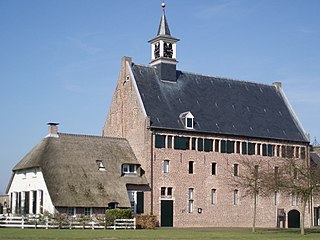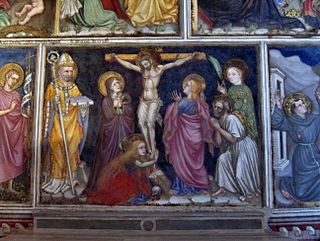
Jacopo De Fazio, best known as the blessed Jacobus da Varagine, or in Latin Voragine was an Italian chronicler and archbishop of Genoa. He was the author, or more accurately the compiler, of Legenda Aurea, the Golden Legend, a collection of the legendary lives of the greater saints of the medieval church that was one of the most popular religious works of the Middle Ages.
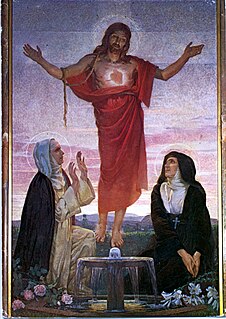
The devotion to the Sacred Heart is one of the most widely practiced and well-known Roman Catholic devotions, taking the heart of the resurrected Body as the representation of the love by Jesus Christ God, which is "his heart, pierced on the Cross", and "in the texts of the New Testament is revealed to us as God's boundless and passionate love for mankind".

The Golden Legend is a collection of hagiographies by Blessed Jacobus de Varagine that was widely read in late medieval Europe. More than a thousand manuscripts of the text have survived. It was likely compiled around the year 1260, although the text was added to over the centuries.

Saint Rita of Cascia was an Italian widow and Augustinian nun venerated as a saint in the Roman Catholic Church. Rita was a child bride, married before the age of 12. The marriage lasted for eighteen years, during which she is remembered for her Christian values as a model wife and mother who made efforts to convert her husband from his abusive behaviour. Upon the murder of her husband by another feuding family, she sought to dissuade her sons from revenge.
Devotio Moderna, or Modern Devotion, was a movement for religious reform, calling for apostolic renewal through the rediscovery of genuine pious practices such as humility, obedience, and simplicity of life. It began in the late fourteenth-century, largely through the work of Gerard Groote, and flourished in the Low Countries and Germany in the fifteenth century, but came to an end with the Protestant Reformation. It is most known today through its influence on Thomas à Kempis, the author of The Imitation of Christ, a book which proved highly influential for centuries.

St. Margaret Mary Alacoque, V.H.M. (1647–1690), was a French Roman Catholic Visitation nun and mystic, who promoted devotion to the Sacred Heart of Jesus in its modern form.

A beguinage, from the French term béguinage, is an architectural complex which was created to house beguines: lay religious women who lived in community without taking vows or retiring from the world.
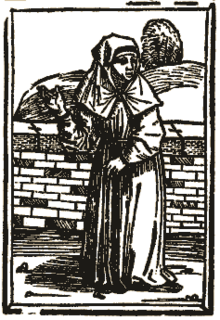
The Beguines and the Beghards were Christian lay religious orders that were active in Northern Europe, particularly in the Low Countries in the 13th–16th centuries. Their members lived in semi-monastic communities but did not take formal religious vows. That is, although they promised not to marry "as long as they lived as Beguines," to quote one of the early Rules, they were free to leave at any time. Beguines were part of a larger spiritual revival movement of the thirteenth century that stressed imitation of Christ's life through voluntary poverty, care of the poor and sick, and religious devotion.
Osbern Bokenam (1393?–1464?) was an English Augustinian friar and poet.
A canoness is a member of a religious community of women living a simple life. Many communities observe the monastic Rule of St. Augustine. The name corresponds to the male equivalent, a canon. The origin and Rule are common to both. As with the canons, there are two types: canonesses regular, who follow the Augustinian Rule, and secular canonesses, who follow no monastic Rule of Life.
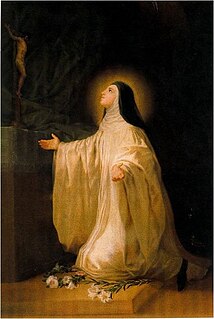
Saint Lutgardis of Aywières is a saint from the medieval Low Countries. She was born in Tongeren, known as Tongres in French, and entered into religious orders at the age of twelve. During her life various miracles were attributed to her, and she is known to have experienced religious ecstasies. Her feast day is June 16.
Mother Dionisia Talangpaz (1691–1732), is a Filipino Roman Catholic figure. Along with her sister Cecilia Rosa de Jesús Talangpaz, she founded the "Beaterio de San Sebastián de Calumpang", in 1719. The Augustinian Recollect Sisters is the second-oldest native Filipino congregation for women religious founded in the Philippines, after the Religious of the Virgin Mary, established by Venerable Mother Ignacia del Espíritu Santo.

Saint Catherine de' Ricci, O.S.D., was an Italian Dominican Tertiary sister. She is believed to have had miraculous visions and corporeal encounters with Jesus, both with the infant Jesus and with the adult Jesus. She is said to have spontaneously bled with the wounds of the crucified Christ. She is venerated for her mystic visions and is honored as a saint by the Catholic Church.

In the history of the Catholic Church, laywomen and women in religious institutes have played a variety of roles and the church has affected societal attitudes to women throughout the world in significant ways. Women constitute the majority of members of consecrated life within the Catholic Church: in 2010, there were around 721,935 professed women religious.
The Augustinian Convent of Bethany existed in Mechelen, Belgium, from 1421-1783. It belonged to the Congregation of Windesheim.
Jacoba of Loon-Heinsberg, was a noble woman from the Low Countries who was the abbess of Thorn Abbey from 1446 to 1454. She was the daughter of John II of Loon and her half-brother, Jan van Heinsberg, was bishop of the Prince-Bishopric of Liège. She withdrew to the Convent of Bethany in Mechelen in 1455; her 1468 will indicates she left a printing press to the convent.
Alijt Bake was a religious woman who was prioress of the Galilea convent in Ghent, Belgium. Among her writings are a spiritual autobiography containing accounts of encounters with Christ.
Blessed Mattia Ciccarelli - in religious Cristina - was an Italian Roman Catholic professed religious from the Order of Saint Augustine noted for her ecstasies and the reception of the stigmata. The religious was also known for her generous donations to the poor of the Abruzzo region despite being in the cloister.
Jacob Cornelis van Slee (1841–1929) was a Dutch Reformed clergyman and scholar. He was the author of a study of the Windesheim Congregation, De kloostervereeniging van Windesheim, and between 1875 and 1900 contributed articles on theologians to the Allgemeine Deutsche Biographie.


